
The prototype Laguna blasts along on plane with a family of five on board. Built by Gordo Barcom in Texas in three months of spare time.
Contents:
Contact info:
Jim Michalak
118 E Randall,
Lebanon, IL 62254Send $1 for info on 20 boats.
Jim Michalak's Boat Designs
118 E Randall, Lebanon, IL 62254
A page of boat designs and essays.
(15Sep09)This issue will give a few thoughts about Birdwatcher cabins. The 1 October issue will repeat the bevels essay.
THE BOOK IS OUT!
BOATBUILDING FOR BEGINNERS (AND BEYOND)
is out now, written by me and edited by Garth Battista of Breakaway Books. You might find it at your bookstore. If not check it out at the....ON LINE CATALOG OF MY PLANS...
...which can now be found at Duckworks Magazine. You order with a shopping cart set up and pay with credit cards or by Paypal. Then Duckworks sends me an email about the order and then I send the plans right from me to you.
THE LAKE MONROE INDIANA MESSABOUT WILL TAKE PLACE ON SEPTEMBER 18, 19, AND 20...
Organizer John McDaniel writes...
"Check the messabout website: http://pwp.att.net/p/pwp-mwmess for the latest event news, photos of last year's happening, maps, and accomodation information. September is a busy month in the Lake Monroe area, so if your a hotel person rather than a camping type, you might want to book your hotel now."
Birdwatcher Cabins
HISTORY...A long time ago, in 1989, I built and launched my Bolger Birdwatcher. It was the second Birdwatcher ever built and I probably would not have built it if not for the words of the first builder (Ron Mueller ?) who told me the idea really worked. I had seen Phil's first drawings of it a few years earlier and in 1986 Phil wrote up an essay about the idea in the old Small Boat Journal. Phil later told me the Birdwatcher cabin was most likely the only real original thing he had thought up and I've got to tell you that in the 1800's I think anything you might imagine was tried. Later I decided that it took the invention of high strength clear plastic like Plexiglass to make the Birdwatcher idea work. Anyway, here is my old Birdwater a long time ago:

Not a great photo to be sure. I still have my Birdwatcher and see no need to replace it since it is still in fine condition, stored indoors.
THE IDEA BEHIND THE BIRDWATCHER....
...is that the crew rides inside sitting low as in an open skiff. Thus the crew weight, which is often the heaviest part of a small boat, is always down low. Next, they ride inside a waterproof Plexiglass "room", more or less just like you ride inside your car in its glassed in room. This is the cabin. Essentially all of the volume of the boat becomes the cabin. You steer from inside and handle the sails from inside. Here is an old photo of Bob and Sue Archibald riding up front in the cabin of my Birdwatcher:

Now, unlike your car the BW cabin was designed with a slot down the center, from stem to stern, wide enough to move about in. So you can stand up on the centerline and walk the length of the boat. At least in good weather. In bad weather the slot is closed with a fabric slot. You can sail in the rain without getting wet. In good weather with mild winds the skipper can sit up on the little aft deck and steer with his feet. Boy, I quickly learned there were many unusual combinations made available. If you lash the tiller BW would sometimes self steer very nicely. Then you walk to the forward end of the slot and watch the waves slide past the bow. And I learned that if you left the slot cover off while trailering you can look in your rear view mirror and see all the traffic behind you, through the open slot. With any other boat this size all you see in your rear view mirror is a big boat chasing you.
I never found the BW cabin to be uncomfortable. I think the dark tinted windows are a must but others seem to feel differently. Actually on a hot day you can always sit in the shade, and the sail usually provides a downdraft that flows through the cabin.
YOU GET A BIG CABIN...
...for the size of your boat, of course, since the whole hull is your cabin. In BW, and in most of the BW cabins I designed, you can sit at the tiller and see from stem to stern and all the volume is available to you. Here is a photo of the interior of Gerry Scott's IMB, a BW design I did that is only 13' long:

We had five adults in this boat at one time. The cabin is 8' long and meant to sleep one on the floor centerline but clearly it would sleep two good friends if they had a way to fill in the place between the seats to provide a flat that is 5' wide. There is no way you could get such a large and airy cabin in anything this size except in a BW type hull. My 19' Jewelbox has room to sleep four adults in its cabin. (The original BW would sleep three, one spot missing because of the use of a centerboard (which is off center)).
AND YOU HAVE SAFETY...
In some ways I think this is the real benefit of the BW cabin. With the crew weight down low and the cabin top up high, most BW hulls will self right from a full knockdown with no one getting wet. And with no extra ballast required. The original BW has a 1" thick bottom with 1/4" elsewhere so the weight was down low to start with.
Now, with a normal cabin hull the crew sits in the stern raised up a couple of feet, at least, because they must see over the cabin top in front of them. So if you have a 4' deep cabin for some sort of sitting headroom then the cockpit needs to be raised up say 2' for crew vision. And their weight goes up with them. Ballast must be added down low to counteract that in a knockdown. I think as a general rule of thumb a normal cabin hull that is supposed to self right will have maybe 40 percent minimum of its weight in ballast. So a 1000 hull might have 400 pounds of lead down low under the bottom. BW doesn't need that (but it is still prudent to test your BW in shallow water to be sure). So a BW hull might be 40 percent lighter than a similar traditional hull. So there is a lot less weight to trailer around.
And a lot less draft. My BW, over 24' long and about 700 pounds empty, draws less that 3" of water with the board up! As you see in the first photo of it, a quick pull on the snout will get it a third of its length out of the water. Launching is simple to say the least. I like to show this photo of Chris Feller's great Philsboat pulled over half way out of the water stern first. Try that with your ballasted fin keeler!

Philsboat is only 15' long but it will hold three or four adults like IMB. You can see how I tinkered with the original BW design as I went along. In general I tried to change the things that bothered me about the original BW. So mine are smaller (my BW is 30' long from trailer tongue to rudder tip), with simple squared off cabins (my BW has some double bevel fitting in those fancy sloped cabin ends), and simple square off sterns (got away from the welded rudder linkage required by the pointy stern and Phil had no intention of ever putting a motor on BW and thought we were all rat race wimps for wanting one). And I went back to that other great Bolger reinvention, the leeboard.
And speaking of safety, you can't fall out of the thing as long as you don't go walking on the cabin top. Imagine sailing with a bunch of kids in a flush deck boat. You'd get a little worried. Now put them inside the BW cabin and let them run around. They can see out just like in a car.
DOWNSIDES....
I'd say there are only two real disadvantages to the BW cabin. One is that the Plexiglass is expensive and in some areas might be hard to find. As I recall way back in 89 I spent $1200 on my BW project and over $400 of that was in the Plexiglass. I dunno if there is anything better than Plexiglass for this. Some have tried Lexan but Lexan is apparently softer and more prone to scratching and impossible to polish. Also Lexan seems to be harmed by some common chemicals, like the stuff they put in mosquito spray.
The other downside was a bit of a surprise to me. It's the flip of the "I can see outside anywhere" idea. The problem is that everyone else can see inside. So you must keep things tidy and use discretion. Especially with tinted glass you can't see out after dark. But if you light a lantern I assure you that everyone can see you inside even if you can't see them. So curtains might be a good investment.
WELL...
I am really sold on the BW idea and will continue to draw them.
Philsboat
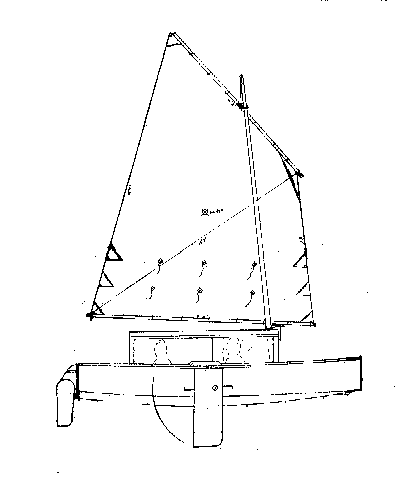
PHILSBOAT, SAILBOAT, 15' X 5.5', 550 POUNDS EMPTY
Philsboat is essentially an IMB with the nose extended to a pointy bow. The width and multichine configuration are the same as IMB's. The cabin is 3" deeper because Phil is at least 3" taller than most of us. In a boat with a Birdwatcher cabin like this one added depth to the cabin makes it safer in that the righting forces in a knockdown are greater. That would be true of any boat if the center of gravity did not move with the cabin roof but with the normal cruiser adding depth to the cabin also means raising the crew deck up so the folks can see over the raised cabin. And that means the CG is elevated too, and then all bets are off concerning self righting. But with a boat like Philsboat eveyone rides down low inside looking out through the windows.
Here is a photo of Bob Williams' IMB:
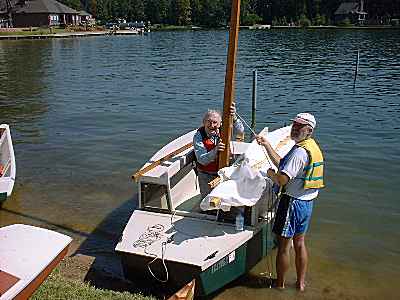
In addition to the pointy bow and added headroom I added what I hope is a serious motor mount. Probably 3hp will drive it as fast as it will ever go and that at part throttle. But the motor well gets to looking pretty large even for such a small motor. For one thing it must be deep to put a short shaft motor on a deep stern like this so I ran it straight down to the boat's bottom. Working on the motor down it its well will be about impossible and you might need to keep an eye on your knuckles when you pull the starting rope. And the well must be surprisingly wide to allow the motor to swivel in steering although the usual case here will be to keep the motor locked straight ahead and steer with the tiller. The wide well pushed the rudder off center and you need a crooked tiller or rudder linkage to make it all work. I opted for a simple but crooked tiller.
I also added low seats like those I saw added to the two IMB's that came to the Lake Conroe Messabout. Pretty much the same as what I have in Scram Pram where the seats do double duty as water ballast tanks. Philsboat seats could easily be converted into water ballast tanks also but the IMB capsize tests imply the ballast isn't needed.

The sail rig uses a balanced lug, 113 square feet and the same as that of a Bolger Windsprint.
Philsboat uses taped seam construction. Five sheets of 1/4" plywood, five sheets of 3/8" and three sheets of 1/2" plywood.
Actually the size and material list for Philsboat are about the same as that of Scram Pram. So which boat would be better? Take Philsboat if you are a pointy bow guy. It should be better in really rough water. On the other hand Scram is wider and roomier. It has a flat step through bow that will splash and spit in rough water but makes beaching a very nice experience.

Update, 2007. Chris Feller completed his Philsboat, probably the first prototype completed, and brought it to the 2007 Rend Lake Messabout. Very well made and to plans except he used the 91 sq ft lugsail he had on hand for his AF3, with some mast rake changes he calculated with his "sail area math". Sailed correctly rigtht off the drawing board, so to speak. We had a chance to use it for a few really nice days. In a good sailing breeze, say 10 to 15 knots with occasional whitecaps, our gps bobbed between 5.5 and 6mph for two hours of reaching as we crossed back and forth on the big lake. When I used the Philsboat I thought it was probably just as easy to enter from a beach as the blunt bowed Scram. The front deck is about 2' high so you can sit on it and swing you legs around onto the deck and then into the cabin.
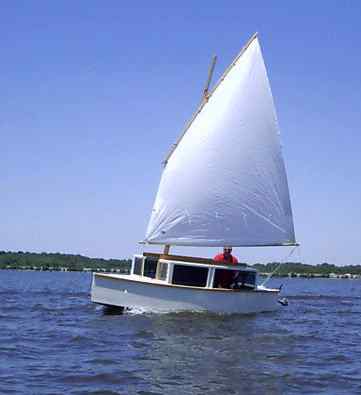
Chris is a big boy but there was plenty of room inside for the two of us and more. Rumor has it that at the campsite the night before Chris slept in the Philsboat on the trailer with an airconditioner in the front hatch plugged into the campsite power. So the boat is plenty big in the way most people would use it.
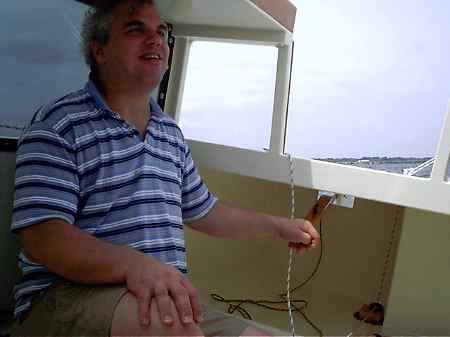
The stern layout has the motor in a small well to one side and the rudder offset to the other side to give the motor room to swing. There is no linkage to the tiller, the tiller is simply "unstraight" so that is falls on centerline at the skipper's hand. Seems to work well and is quite simple. Chris uses a 2hp Honda which has a fairly large cowling for its size and must be rotated 180 degrees to grab reverse. He said the motor well size is a bit too small for that. Karl James had the same problem with his Jewelbox a long time ago and simply cut away the side of the hull in top of the motor well region - after all it is just there for looks. Chris said he tried the boat under power and found it went 6 mph max, just like under sail. No surprize to me. My Birdwatcher also maxes out at 6mph under 3hp and under 5.5 hp. This sort of hull will only go so fast. Add more power and you just dig a deeper hole and make a bigger wake - you won't go faster. But sometimes more power is nice on a windy day.

(As an update, Chris has brought his Philsboat to several more Rend Lake meets. In 2008 the meet was very windy and Philsboat got a full windows wet knockdown with Chris and Tom Hamernik on board. She self righted with no issues and they kept right on sailing, but Chris confessed he has 100 pounds of lead shot under the seats. Also he is using a 3hp vintage Johnson which he says is quieter and smoother than the Honda.)
You might recall from the Prototypes section recently that there was another Philsboat being built in California. That one last I heard was about to be launched. Has more changes from blueprint than Chris's boat but still is pretty true to form. Seems to be known as Bumble and made by Rex Meach.

And in New Zealand Rob Kellock has been sailing his with a junk rig. He has been knocked down a couple of times and self righted as planned:
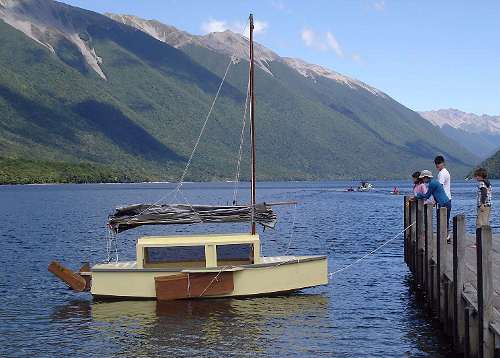
Plans for Philsboat are $45.
Prototype News
Some of you may know that in addition to the one buck catalog which now contains 20 "done" boats, I offer another catalog of 20 unbuilt prototypes. The buck catalog has on its last page a list and brief description of the boats currently in the Catalog of Prototypes. That catalog also contains some articles that I wrote for Messing About In Boats and Boatbuilder magazines. The Catalog of Prototypes costs $3. The both together amount to 50 pages for $4, an offer you may have seen in Woodenboat ads. Payment must be in US funds. The banks here won't accept anything else. (I've got a little stash of foreign currency that I can admire but not spend.) I'm way too small for credit cards.
I think David Hahn's Out West Picara is the winner of the Picara race. Shown here on its first sail except there was no wind. Hopefully more later. (Not sure if a polytarp sail is suitable for a boat this heavy.

Here is a Musicbox2 I heard about through the grapevine.

This is Ted Arkey's Jukebox2 down in Sydney. Shown with the "ketchooner" rig, featuring his own polytarp sails, that is shown on the plans. Should have a sailing report soon.

And the Vole in New York is Garth Batista's of www.breakawaybooks.com, printer of my book and Max's book and many other fine sports books. Boat is done, shown here off Cape Cod with mothership Cormorant in background, Garth's girls are one year older. Beautiful job! I think Garth is using a small lug rig for sail, not the sharpie sprit sail shown on the plans, so I will continue to carry the design as a prototype boat.

And a new Down Under Blobster is off cruising under outboard power as it waits for its sailrig.

A view of the Caroline prototype showing a lot of the inside, crew on fore deck. Beautiful color:

And here is another making I think its maider voyage in the Texas 200. (I'm told the Chinese rig will be replaced by the blueprint rig.)

I gotta tell you that on the Caroline bilge panels I made an error in layout and they are about 1" too narrow in places on the prototype plans. I have them corrected but it always pays, even with a proven design, to cut those oversized and check for fit before final cutting.
And a Deansbox seen in Texas:

And in Texas Gordo Barcom has completed the first Laguna and I hope to give a full report soon. Here he blasts along on his first flight:

AN INDEX OF PAST ISSUES
Hullforms Download (archived copy)
Plyboats Demo Download (archived copy)
Brokeboats (archived copy)
Brian builds Roar2 (archived copy)
Herb builds AF3 (archived copy)
Herb builds RB42 (archived copy)